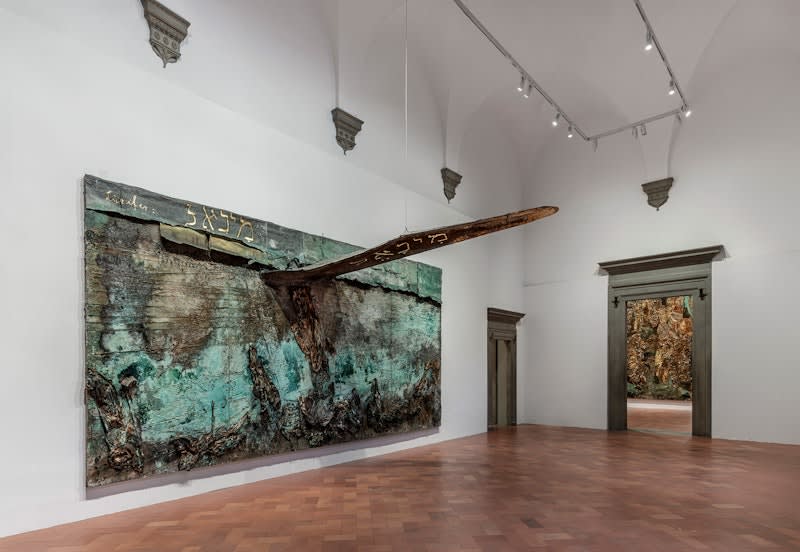Anselm Kiefer: Angeli caduti Brooklyn Rail's ArtSeen
By JoAnna Novak
[...]
The first work in Kiefer’s staggering, heady exhibition is a painting, Engelssturz (Fall of the Angel) (2022-2023) though with Kiefer it’s never simply a painting. It is an enormous canvas of emulsion, shellac, fabric, sediment (charcoal and electrolysis), acrylic, oil, and gold leaf—enough gold leaf to make Simone Martini and Lippo Memmi’s Annunciation with St. Maxima and St. Ansanus down the street at the Uffizi look modest. And yet how much Kiefer’s Engelssturz has in common with the gilded Sienese altarpiece, where the Archangel Gabriel’s message to the Virgin Mary is inscribed, right there, on the canvas. Like most of the work in Angeli caduti, Engelssturz, the title, is scrawled in the upper left. Hebrew characters spell out the archangel’s name, Michael. A walk around the painting, reveals the stretcher-power necessary to support such a gargantuan canvas, as well as more writing: “Eschaton.” World’s end, yes, and also a reference to the Eschaton-Anselm Kiefer Foundation housed at the artist’s once studio in Barjac, France. (It became a massive excavation project.)
I have no struggle imagining Kiefer unearthing anything, let alone digging holes, building tunnels, or constructing crypts. The sheer scale and accretive materiality of his paintings relentlessly announce their labor. Forty-three steps up from the courtyard, in Luzifer (2012-2023), the figure of Lucifer tumbles from the sky or, in the words of my four-year-old son, a fire airplane. Indeed, a jet wing juts from the canvas like a steel palm frond. Again, an inscription, again “Michael,” scrawled in copper on the underside of the metal. Empty tunics (tight brown houndstooth) rent, rumpled, suggest human remains amidst the wreckage.
Wreckage and ruin, ambition and virtue, Kiefer is an archaeologist of the humanities, a miner of human folly and fallibility. Across the eight rooms of Angeli caduti, the apocryphal breadth of his work is on display. Kiefer’s work requires time; the creation of Luzifer spans eleven years. The artist takes time to read and research, to recreate, to riff on a motif, to let the material erode. This exhibition includes Sol Invictus (1995) an example of the sunflower paintings he’s been making for thirty years, in a room that smells like seeds.
Nowhere is this more on display than in Verstrahlte Bilder (Irradiated Paintings) (1983-2023). Comprising sixty works completed over forty years, covering the walls and ceiling an entire room of the exhibition, Verstrahlte Bilder is an immersion, as close to selfie art as I can imagine Kiefer coming. “I put them in a radiated room to destroy them,” Kiefer says of the sixty works in an adjacent video. In the center of the room, a long rectangular mirror allows you to see the ceiling without craning, so long as you’re comfortable imposing your own reflection into the work. All of us, fallen angels.














































































































































































